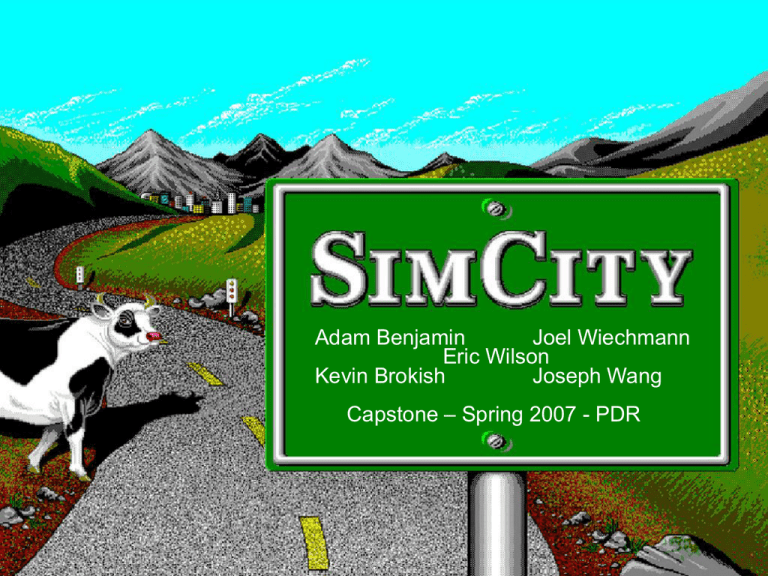Adam Benjamin Joel Wiechmann Eric Wilson Kevin Brokish
advertisement

Adam Benjamin Joel Wiechmann Eric Wilson Kevin Brokish Joseph Wang Capstone – Spring 2007 - PDR Presentation Objectives Propose and Present the Project Convince of feasibility Demonstrate appropriate complexity Presentation Outline •Vision •Mission •Strategy •Implementation Vision Inspiring a Vision Vision Mission Purpose of Existence Mission Statement The mission of SimBoulder is to demonstrate the effective integration of renewable energy power sources Baseline Objectives Model City Power Infrastructure - residential, industrial, commercial and transportation - varying load characteristics - varying power usage based on time of day Integrate renewable and traditional power sources - sense and control percentage of power taken from each source - integration of renewable and traditional sources - storage of renewable and grid power Baseline Objectives Measurement and Display - traditional vs. renewable energy sources - real-time power consumption - Cost & Environmental foot print comparisons Energy Management Demo - incandescent vs. fluorescent - insulation - conservation Function Specifications Boulder Pop. = 90,000 Power consumption = 200 MW Size = 30 square miles Time = 24 hrs SimBoulder • Population = 0 • Power consumption = 2W • Size = 8 square feet • Time = 2.4 min Ratio Power consumption & Area = 100,000,000:1 Time = 600 : 1 Functional Specifications Division of Energy •Residential – 22% •Industrial – 32% •Transportation – 28% •Commercial – 18% Functional Specifications Solar Specs • 6 solar panels • Rated 4V and 100 mA • Lamp = “Sun” Reservoir Specs • Two fish tanks, a pump and a generator • Build generator • Don’t know yet generator specs or power production capabilities Possible Extensions Add wind power Advanced Peak Power Tracker More energy efficient loads Change from DC to AC Weather Simulations: - Shadowing Effect (cloudy day) - Drought (reservoir runs dry) Strategic Approach Creating a Strategy Block Diagram Light Solar Cells Peak Power Converter Capacitor Bank Valve Water Generator Pump Converter Relay Power Management Circuitry Two-way Converter CPU UI Battery AC/DC & Currentlimiting Converter City Environment Controller Power Plant Power Controller Block Diagram – CPU AC/DC & Current-limiting Converter PWM Chip Valve Gate Driver Gate Driver Dimmer Switch Light Power Levels from Various Sources Power Management Circuitry TI MSP430 F1611 Gate Drivers M User Input Crystalfontz CFAG12864BTFH-V M Block Diagram – Solar Power Management Circuitry Solar Panels PWM Chip I/V Tracking Circuitry Block Diagram - Battery System Battery Emergency Cutoff Circuit MOSFET-controlled buck or boost converter PWM Chip I/V Tracking Circuitry Power Management Circuitry Block Diagram - Water System Power Plant Switch Pump Water CPU-Controlled Valve Generator Converter Power Management Circuitry Block Diagram - Power Plant System Power Plant AC/DC Converter CPUControlled Currentlimiting Converter Power Management Circuitry Power Management Circuitry Solar Cells Peak Power Converter Generator Converter Two-way Converter Capacitor Bank Battery AC/DC & Currentlimiting Converter City Power Controller Implementation Beginning to Implement Division of Labor Name Responsibilities Adam Benjamin, Team Member Converters/ Processor Interfaces / Software Eric Wilson, Team Member Converters/ Processor Interfaces Joseph Wang, Team Member Power Management Circuitry Joel Wiechmann, Team Member Interface to CPUs/Peak Power Tracker Kevin Brokish, Team Member Processor Interfaces /Software/Peak Power Tracker Michael Lightner, Project Contact Advisor Cost Analysis • • • • • • • • • • • • Solar Cell Water Pump LEDs (20-30) City-building supplies Generator equipment Battery Electrical components Processor LCD Relay 2 Fish tanks Total $90 $50 $30 $75 $75 $20 $150 $40 $35 $10 $50 $625 Project Timeline Risk Analysis • Insufficient power generation from renewable sources – Increase percentage of power generated from power plant • Availability of generator turbine of size and efficiency – Build our own generator • Interference of noise and magnetic – Shield circuits with appropriate capacitors – Power trace layout on circuit board Questions?

